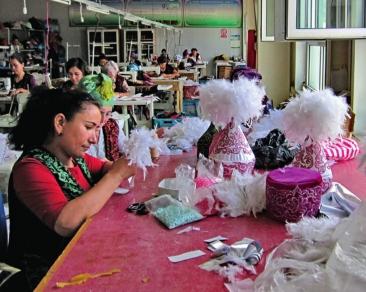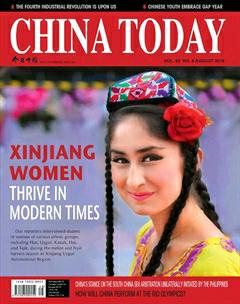Passing on the Kazak Cultural Legacy
By staff reporter JIAO FENG

THE Kazak people constitute the majority of Kazakhstans population. Having also made their homes in such countries as China, Russia, Uzbekistan, Turkey, and Mongolia, their numbers throughout the world total around 18 million. There are 1.6 million Kazak people in China, most of whom live in Ili Kazak Autonomous Prefecture, Altay Prefecture, Mori Kazak Autonomous County, and Bark?l Kazak Autonomous County of Xinjiang Uygur Autonomous Region. Jengisgul is a young Kazak woman who revels in the culture of her people, and is dedicated to sharing and passing it on.
Passion for Kazak Culture
Jengisgul was born into a family of tailors in Tekes County of Ili Kazak Autonomous Prefecture. She has since childhood had a strong appreciation of culture and art. Like most Kazaks, she is outgoing and passionate. She loves singing, writing and composing, and has written more than 20 songs. In 1985, she passed the Ili Normal University entrance examination, where she majored in Kazak language and literature.
Jengisgul told China Today that she loved reading novels in college, especially historical fiction about her own people. As she acknowledged, it was probably due to familial influence that whenever she read descriptions of Kazak clothing, she yearned to see and touch these garments. “I wanted to make them real,” Jengisgul said.
After graduating Jengisgul became a civil servant. Although this afforded her stability and comfort, Jengisgul felt there was something missing in her life. Her great passion for Kazak dress and culture moved her to quit her job in 1998 and devote herself to making Kazak-style clothing. In 1999, she unexpectedly won first prize at a grand feast in Ili Kazak Autonomous Prefecture for 32 costumes she had designed and made.
“I designed that series of costumes based on descriptions from books that included such details as the lengths of robes, styles of cuffs, and designs on waistbands and collar bands,” Jengisgul told us. “But I adopted a modern mode of cutting to make these styles conform more to contemporary tastes,” she added. “Winning the prize not only boosted my confidence, but also established my reputation, and so brought in growing numbers of orders.”
Spread Culture through Needles and Thread
“I didnt give too much thought to making Kazak clothing at first, I saw it just as my own small business. But when it expanded I realized that the industry in fact belongs to every one of my people and my country,” Jengisgul said. “Besides making clothes, I also collect traditional daily-use articles from Kazak households. Although seemingly unimportant, taken as a whole these items constitute a main aspect of our culture.”
The many challenges that Chinese society faced from the 1940s to the 1980s pushed Kazak culture to the brink of extinction, because in the absence of anyone to inherit certain traditional crafts, they became defunct. To make a thorough study of Kazak culture, therefore, Jengisgul takes special pastoral tours every year. There, in grasslands and sandy regions she talks with local elders and seeks out items and books related to local culture.
Discovering and preserving cultural treasures is not easy. Jengisgul once spotted an old, worn-out carpet on the mouth of a pit where naan (a local staple food) were being baked. The woman making the naan told Jengisgul that the carpet served as a dust barrier, and that it had been passed down from generations in her family. As it was old and grubby, although not frayed, it was used to cover the pit. “I bought that carpet immediately, and after soaking it in water for 10 days was able to discern its delicate and beautiful design. It was embroidered in a very fine woolen yarn, but the technique of twisting woolen yarn is no longer in use, so it would be impossible to make one like it today,” Jengisgul said. So far, Jengisgul has restored more than 430 Kazak costume designs and daily-use articles, 180 of which have gone into production.
There are now only a few elders who are familiar with these Kazak crafts. Jengisgul hopes that universities will run degree courses in Kazak dress design, or that a research center or studio specializing in traditional Kazak clothing might be established. “It is my hope that more young people will become interested in traditional Kazak costume, and so carry on the Kazak tradition and culture,” Jengisgul said. After years of research and practice, Jengisgul wrote her book The Traditional Dress of the Kazak in China, which is about to be published. “I believe the Kazak culture in China is unique and so should be documented,” Jengisgul said.
“White Houses”on the Grassland
Jengisgul is also interested in Kazak yurts. “The yurt showcases the ancient Kazak dwelling model and related traditions, customs and culture,” Jengisgul said. She established another company specializing in building yurts while running her clothing business.
The Kazak nomadic lifestyle gave rise to these portable homes, which are similar to the Mongolian yurt. The Kazak yurt is a round tent whose simple appearance belies its complex craft. All the construction materials are handmade, and the yurt is itself manually constructed. This convenient and comfortable dwelling is solid and durable, providing protection against cold and rain – even earthquakes.
The Kazak yurt is covered with white felt on the outside, and its interior decor is contrastingly delicate. Locals call them“White Houses” on the grasslands. China Today reporters saw such a yurt at a handicraft industrial park in Yining City. With an interior space of around 100 sq m, its walls stand three meters high. The dome both visually expands the interior space and guarantees good ventilation. Its floor is covered with thick wool felt embroidered with flowers and grasses, and the walls are hung with exquisitely embroidered tapestries and curtains. It is also equipped with various skillfully crafted and artistic Kazak daily-use articles. Jengisgul owns this yurt, and has hence gained respect as an industrial artist as well as a guardian of the Kazak costume-producing techniques in China.
As society advances, great changes have taken place in the life of the Kazak people in China. Fewer and fewer people master the techniques of yurt construction, which is why Jengisgul decided to carry out research on the relevant techniques and crafts throughout the actual construction of yurts.
Jengisguls yurt displays different designs on its floors, walls and vault. They record the cultural and historical development of the Kazak ethnic group, whose origins go back to the Bronze and Stone Ages. Similar designs have appeared in cliff paintings from over 3,800 years ago in the Tianshan Mountains, Kunlun Range and the Altai Range in Xinjiang.“For example, the flower and grass designs on the carpet signify a prosperous and large family, as the lush grass represents the proliferation of family members. Animals have an important status in the Kazak consciousness, which is why designs such as rams horns, horse mouths, bird wings and camel hooves extensively feature in Kazak daily life. But tradition dictates that such animal-related designs cannot be used on clothing, and there are specific dress codes as to what types of pattern should be worn by women under 18 years old and by married women,”Jengisgul said.
The Kazak cultures of different regions feature different local characteristics. “I once went to Kazakhstan to visit its museums and talk to local experts. I discovered that Kazak culture there has, to a certain extent, been influenced by European culture. But the Kazak people living in China have had less contact with the outside world, and so have kept their culture relatively intact,” Jengisgul said.
In order to give more people an insight into the culture of the Kazak people in China, Jengisgul has transformed her 600 square meters residence into a small museum in which to exhibit the Kazak cultural artifacts she has collected. “The museum still needs further improvements. I also plan to write a book every one or two years and to maintain my research on Kazak culture,” Jengisgul concluded.

